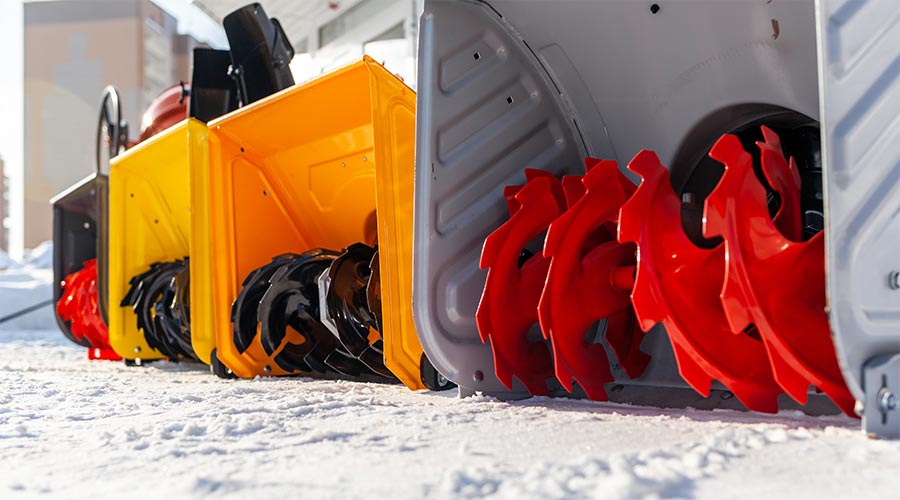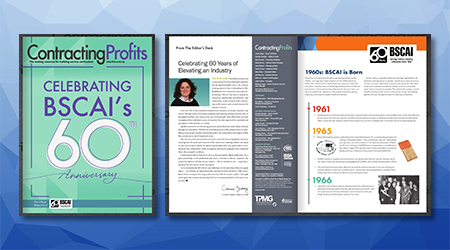
Beyond looking at chemical products, having and knowing how to use the right equipment is a non-negotiable component of adding winter weather services. When it comes to clearing pedestrian walkways, there are commercial-grade push spreaders that allow for controlled and measured application of granular ice melt, helping to ensure product isn’t overused and therefore isn’t wasted.
Thinking beyond the ice, though, snow removal itself requires its own set of tools and techniques. Manual shoveling is the traditional choice for smaller areas like entrances and tight spaces, but a commercial operation looking to service larger properties may find it useful to invest in snow blowers, and potentially even vehicle-mounted snowplows.
For businesses that are just getting into winter services, a plow attachment on an existing work truck is an appealing option. If the services prove popular, making the investment in a vehicle that is more equipped for snow removal (one that can handle a plow and granule spreader system) can help scale the add-on service into a significant source of revenue, particularly if a business can become the go-to option when snow strikes.
Hitting the Market
With the right tools and products in place, the next step for a BSC looking to add winter services is getting the word out. Don’t just raise awareness of these new services. Ensure that potential clients understand their effectiveness and value. This requires a sense of good timing and strong messaging.
Ideally, late summer into early fall provides a useful window to get the word out about winter services. Once the seed is planted, the client can plan their approach before the need turns into an urgent, last-minute search for solutions.
BSCs would benefit from emphasizing the importance of ensuring workers and occupants have access to safe, walkable parking lots and sidewalks, and that the ability to count on that snow and ice removal service allows for peace-of-mind when winter storms come by surprise. Additionally, for the client, having a single provider for both interior and exterior maintenance needs can be compelling—one point of contact, one set of prices, one relationship to maintain.
Looking at the bigger picture, BSCs should consider creating a bundle of services as a sort of one-stop-shop solution for their clients. These can even expand into comprehensive, year-round service packages. By looking at the new services as part of a whole, this can help BSCs lock in longer-term contracts and stabilize revenue streams. In these instances, it also provides the opportunity to retain clients, making the BSC a valuable partner.
In a sense, this is more than superficial cleaning; it’s part of mitigating overall risk, cutting down on likely slip-and-fall incidents when occupants are caught off-guard by snow and ice.
When it comes to setting prices, developing a strategy that makes sense for winter services requires a different approach than writing up typical cleaning contracts. An unavoidable fact is that winter weather services are largely predicated on the weather. And if a BSC is in a region where winter weather can be impactful but infrequent, staying prepared to tackle the job while maintaining profitability can be tricky.
Many companies use a variety of pricing strategies. Per-event pricing is one option—the client is simply charged for the work pertaining to each snow and ice event. There is also the per-inch pricing model where BSCs set the fee according to the total snowfall accumulation—$X per inch of snow. There are also seasonal contracts, entailing a fixed price of services for an entire season, regardless of what weather occurs.
Sexton advises contractors to “forecast needed inventory based on total estimated square footage/acres of service area, averaged with a minimum of five years of weather history.” This data-driven approach helps prevent shortages or overstocking.
While climate shifts and client expectations can often be unpredictable, and staying ahead of the curve is a race against competitors, diversifying into winter weather services is a strategic move that can present a path to more stable year-round revenue. By investing in the right equipment, crafting a targeted marketing message, and implementing a sensible pricing structure, BSCs can transform a potential seasonal lull into a period of growth.
Jackson Silvanik is a former Managing Editor for Contracting Profits.
Winter Weather Services Prove Promising

 Celebrating BSCAI's 60th Anniversary eBook
Celebrating BSCAI's 60th Anniversary eBook The Down and Dirty on Cleaning in Virus Season
The Down and Dirty on Cleaning in Virus Season How Surfactant Use is Expanding in Commercial Cleaning
How Surfactant Use is Expanding in Commercial Cleaning